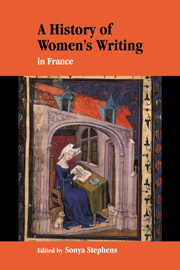Book contents
- Frontmatter
- Contents
- Notes on contributors
- Introduction
- 1 Female voices in convents, courts and households: the French Middle Ages
- 2 To choose ink and pen: French Renaissance women's writing
- 3 Altering the fabric of history: women's participation in the classical age
- 4 The eighteenth century: women writing, women learning
- 5 Eighteenth-century women novelists: genre and gender
- 6 The nineteenth century: shaping women
- 7 1900–1969: writing the void
- 8 From order to adventure: women's fiction since 1970
- 9 Changing the script: women writers and the rise of autobiography
- 10 Women poets of the twentieth century
- 11 Voicing the feminine: French women playwrights of the twentieth century
- 12 Feminist literary theory
- Bibliographies
- Index
1 - Female voices in convents, courts and households: the French Middle Ages
Published online by Cambridge University Press: 25 September 2009
- Frontmatter
- Contents
- Notes on contributors
- Introduction
- 1 Female voices in convents, courts and households: the French Middle Ages
- 2 To choose ink and pen: French Renaissance women's writing
- 3 Altering the fabric of history: women's participation in the classical age
- 4 The eighteenth century: women writing, women learning
- 5 Eighteenth-century women novelists: genre and gender
- 6 The nineteenth century: shaping women
- 7 1900–1969: writing the void
- 8 From order to adventure: women's fiction since 1970
- 9 Changing the script: women writers and the rise of autobiography
- 10 Women poets of the twentieth century
- 11 Voicing the feminine: French women playwrights of the twentieth century
- 12 Feminist literary theory
- Bibliographies
- Index
Summary
Women writers and readers have shaped the course of French literature from its inception, although their history is a fragmented one that includes silence and engagement, marginalization and empowerment, convention and originality, fragmentation and continuity. It is, moreover, a history that requires us to re-examine and expand the concepts of language, genre, national identity and authorship often implied in the terms ‘French literature’ in order to appreciate fully the contribution of literate women who lived in the territory of contemporary France or who wrote in French during the long period extending from the Merovingian dynasty (sixth century) to the Hundred Years' War (1337–1453).
The first Frankish women writers wrote in Latin. The earliest female-authored works in the French vernacular were composed not only in France but also in England, where Anglo-Norman was the language of the elite from the Norman Conquest (1066) until the fourteenth century. Women's writings include not only lyric poetry and courtly narratives, genres recognized as having a strong aesthetic component, but also letters, devotional writing, saints' lives and didactic treatises. Female authorship is not always easily recognizable, given the conditions of manuscript culture. Many texts written in female voices are anonymous.
Other texts name a woman author whose historical identity remains shrouded in mystery. Even when a name can be linked to a historical woman, in certain cases scholars have argued that male clerics have shaped or wholly fabricated women's words.
- Type
- Chapter
- Information
- A History of Women's Writing in France , pp. 10 - 40Publisher: Cambridge University PressPrint publication year: 2000
- 1
- Cited by

